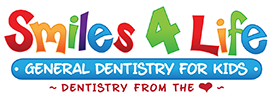Dental Cleanings for Children in Columbus, OH
Every six months, kids over the age of three to five need a professional dental cleaning. These preventive dental care appointments allow us to remove tartar that isn’t washed away during daily brushing and flossing. Regular dental cleanings help deter cavities and gum disease. We’ll also evaluate your child’s gums and track changes over time.
Do Kids Get Gum Disease?
Absolutely! Kids can develop gum disease. In fact, half of American kids have some level of gum disease, ranging from gingivitis to advanced periodontitis.
The following risk factors and symptoms can equip parents to understand their children’s potential for gum disease. If you notice any of these symptoms, especially if your child has risk factors, contact Smiles 4 Life for a periodontal examination.
DID YOU KNOW?
Half of American kids have some level of gum disease, ranging from gingivitis to advanced periodontitis.
Risk factors for children’s gum disease include but are not limited to:
- Hormone fluctuations
- Diabetes or blood sugar issues
- Mouth breathing
- Sugary, starchy diet
- Genetics
- Poor oral hygiene
- Using an asthma inhaler
- Some medications (dry mouth contributes to gum disease risk)
Gum disease symptoms parents should watch for:
- Bright red gum tissue
- Chronic bad breath
- Gum swelling or puffiness
- Pus between teeth at gumline
- Bleeding when brushing and flossing
- Loose permanent teeth for no apparent reason
- Distance between teeth increases
- Foul taste in mouth
- Built-up plaque and tartar at the gum line
- Tooth/gum sensitivity
- Pain in the gums or teeth
- Sores on gum tissue
What Happens at a Dental Cleaning?
If your kiddo does not have gum disease, a regular cleaning every six months is advised. You can opt to schedule a checkup and cleaning consecutively. The visit can take up to a few hours, but usually lasts about an hour and a half.
One of our talented and gentle hygienists will inspect all teeth and the gum tissue supporting them. We probe the gums to determine whether pockets have formed at the gum line. The depth of gum pockets tells us whether gingivitis or a more advanced form of gum disease is present. Logging the measurements allows us to build a history of gum health.
Plaque, when left on or between teeth for 48 hours, calcifies into a hard substance known as tartar or calculus. Tartar cannot be removed with brushing and flossing. Only a dental cleaning offers this level of gum care.
After evaluating the gum tissue, the hygienist cleans every tooth thoroughly and polishes the teeth to remove topical stains. The result? A bright smile, silky-smooth teeth, and fresh breath.
What If My Child Develops Gum Disease?
Children with gingivitis or another level of gum disease will need a deep cleaning. We administer anesthetic to ensure the child’s comfort, then remove plaque and tartar from just below the gum line. This process is called scaling. Next comes root planing, where we smooth rough areas on teeth roots. Ledges and crevices on teeth roots provide excellent opportunities for plaque and tartar to build up. By smoothing rough areas, the plaque has fewer places to hide.
A deep cleaning helps gums heal and reattach firmly to teeth. Patients may need two visits to complete the deep cleaning. Then, over time, measuring gum pocket depth will reveal the effectiveness of the treatment.
Additionally, the hygienist can help you and your child improve the effectiveness of your daily dental hygiene routine. Learning the best practices for brushing and flossing and using the appropriate tools and products, coupled with twice-a-day brushing and daily flossing, will help your child’s gums stay healthy.
Schedule Your Kiddo’s Cleaning Today
Our team at Smiles 4 Life invites you to contact our office today to schedule your child’s cleanings and checkups. We hope to partner with you and your children to support oral health and a beautiful smile. Establishing proper dental home hygiene and prioritizing professional dental care will help your little ones grow into adults who value their health.



